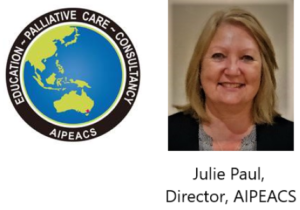
JULIE’S UPDATE: JULY 2025
今月は、緩和ケアにおけるコミュニケーションの重要性というテーマを継続して取り上げたいと思います。 最近、欧州緩和ケア協会(EAPC)のブログでは、重症患者やその家族が情報開示を望まない場合、特に文化的な違いを背景に、臨床情報をどのように提供すべきかというジレンマに焦点を当てていました。(2025年7月https://eapcnet.wordpress.com/ )
すべての患者とその家族が完全な情報開示を望むわけではありません。例えば、成人した子供が、医療チームに親の病状の詳細を完全に開示しないことで親を保護したいと考える場合です。これは、患者の健康状態について完全に情報を得る権利を基盤とした法的・倫理的な原則に基づくオープンなコミュニケーションと完全な情報開示を重視する西洋文化とは、非常に異なるものと見なされることがあります。
では、患者と家族が信頼を失ったり、無力感を感じたりすることなく、患者と医療チーム、患者と家族のコミュニケーションスタイルや期待が異なる場合、患者の最善の利益を考慮してどのように対応すべきでしょうか。
2022年にEAPCで、臨床ガイドラインの開発を目的としたグローバルな多職種ステークホルダー会議が開催されました。これらのガイドラインは、このような状況でのコミュニケーションを改善し、ケアにおける緊張を乗り越えるための枠組みを提供することを目的としています。
ガイドラインは、患者と医療従事者の臨床的、文化的、社会的背景が、健康情報とその解釈に影響を与えることを認識しています。 緊張は一部の文化的背景で発生する可能性がありますが、医療チームが患者と家族に耳を傾け、彼らの要望にオープンな姿勢で向き合い、コミュニケーションの好みについて尋ねる時間を取ることで、適切に管理できます。
すべての患者を個人として扱い、適切な質問を投げかけ、特に彼らの視点に耳を傾けることが重要だと考えます。そうすることで、彼らの希望や好みに沿ったケアを提供できる可能性が高まります。
この作業グループから開発された以下のリソースがあります:
– コミュニケーションのヒントをまとめた実践的なインフォグラフィック(注:2つ目は日本語に翻訳されています)practical infographic with communication tips
– 日本語字幕付きの短い動画 short video
これらのガイドラインに関するご意見や、臨床実践を向上させ、患者と家族とのコミュニケーションを改善するために活用できる新しい情報を学んだかどうか、お聞かせいただければ幸いです。
いつも通り、この分野の追加リソースにご興味がある場合はお知らせください。お送りいたします。ご状況をお知らせください。緩和ケアに関するご意見や経験を共有いただくことで、互いに学び合えることを楽しみにしています。
EAPCブログの購読を希望される方は、このリンク https://eapcnet.wordpress.com/ をご利用いただき、右上にあるメールアドレスを入力してください。
(注:この更新情報は、主にEAPCブログ2025年7月号を参考にしています)
安全にお過ごしください。
ジュリー
ジュリー・ポール – OAM
-
-
Disclaimer: JULY 2025 免責条項:
Julie’s Update シリーズ内の内容につき正確な情報の提供に細心の注意を注いでいますが、特にある事柄についての専門的意見を提供するものではありません。このシリーズに含まれる情報は、独立した専門家の見解に取って代るものではありません。また、医療上の助言として利用したり、何らかの疾患の治療、手当、又は、予防のために使用されるものではありません。
このシリーズにより提供される情報の利用、依存によるいかなる法的責任、怪我、紛失、損害については、責任は負いません 。
-
Julie’s Update: JULY2025(原文)-
- ‐ A practical infographic with communication tips ( note the second one has been translated into Japanese) practical infographic with communication tips
- ‐ A short video that can have subtitles translated to Japanese short video
This month I would like to continue our theme on the importance of communication in palliative care. In a recent European Association for Palliative Care (EAPC) blog the focus was on the dilemma we sometimes have on how to provide clinical information when seriously ill people or their families prefer non-disclosure, which is often grounded on cultural differences. (July 2025, https://eapcnet.wordpress.com/ )
We know not all patients and their families want full disclosure. For example, adult children wanting to protect their mum or dad by not wanting the medical team to provide full details of their medical condition. This is sometimes seen as very different to western cultures that are grounded on legal and ethical principles of open communication and full disclosure based on the patients right to be fully informed of their health condition.
So how do we manage this in the best interest of our patients, when there are different communication styles or different expectations from the health care team and the patient and family of what the patient wants to or does not want to know, without the patient and family losing trust and feelings of disempowerment.
In 2022 a global multidisciplinary stakeholder meeting was held at EAPC with the aim of developing clinical guidelines. The guidelines were to provide a framework for how we can improve our communication in these situations and navigate the tensions that can arise with care.
The guidelines are centred on the recognition that health information and how the information is interpreted is shaped by clinical, cultural and social contexts of both the patient and the health professional. Tensions will most likely occur in some cultural contexts, however they can be managed well by the health care team when we take time to listen to patients and families, be open minded about what they want and ask about communication preferences.
I think it is important to remember if we treat all patients as individuals and ask the right questions and importantly listen to their perspectives, we are more likely to provide care according to their wishes and preferences.
The following resources have been developed from this working group:
-
I am very interested in your thoughts on these guidelines and whether there was any new information you learnt that you can use to enhance your clinical practice, and improve communication with patients and families.
-
As always, if you are interested in more resources in this area, please let me know and I can forward them through to you. Please let me know how you are going, as we enjoy sharing your thoughts and experiences on palliative care, so we can continue to learn from each other.
-
If you are interested in subscribing to the EAPC blog use this link https://eapcnet.wordpress.com/ and provide your email address on right hand side at the top.
-
(Please note: This update has been primarily referenced from the EAPC Blog July 2025)
-
Stay safe and take care.
-
Julie
-
Julie Paul – OAM
-
-
-
